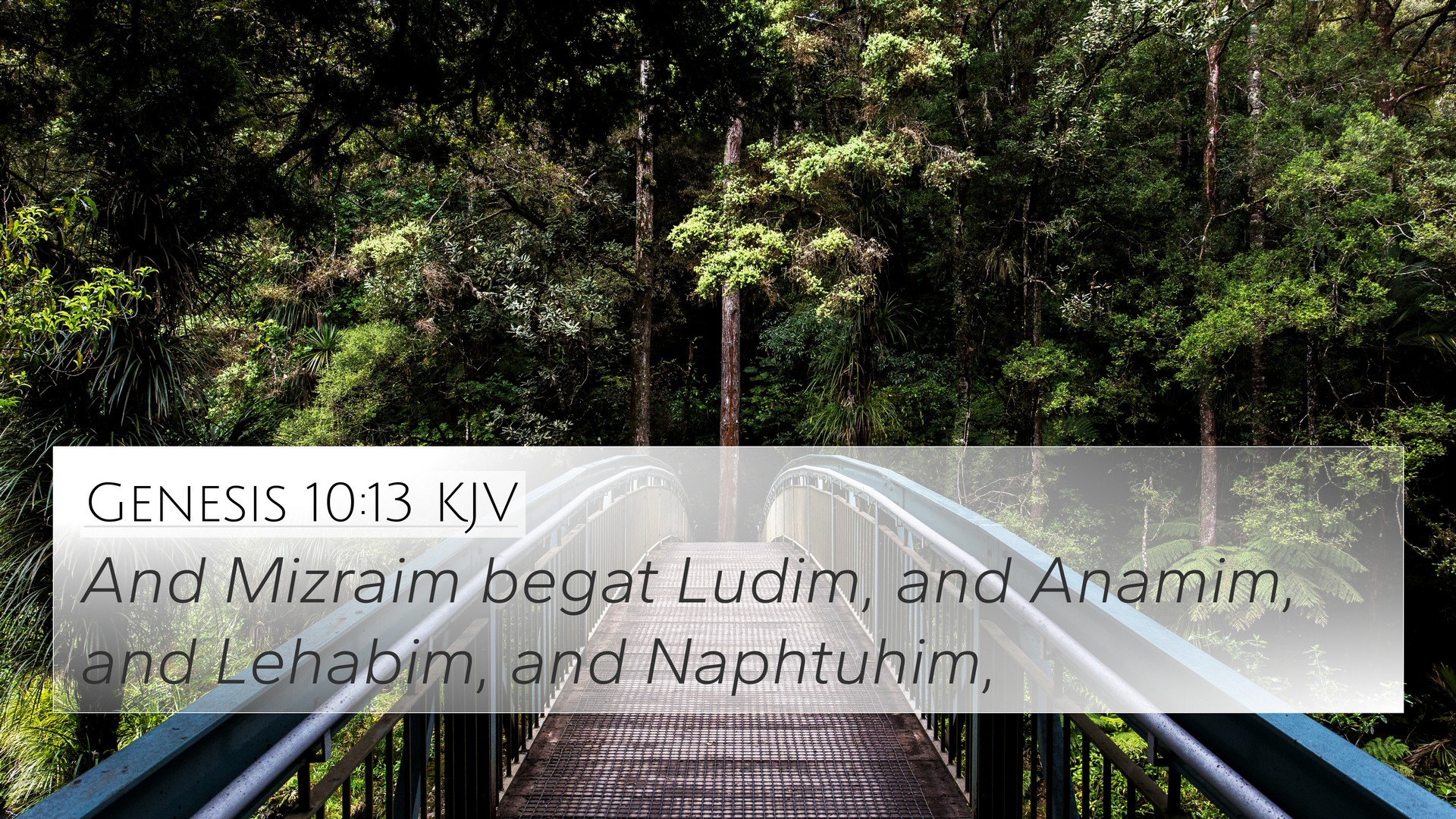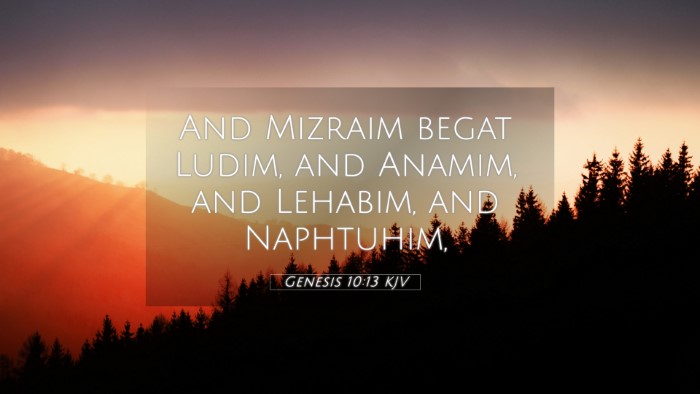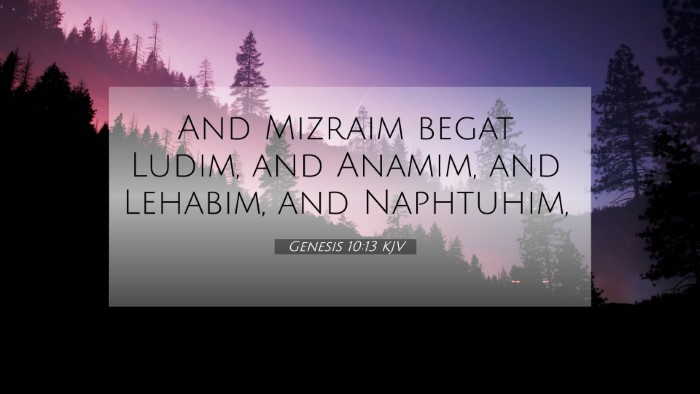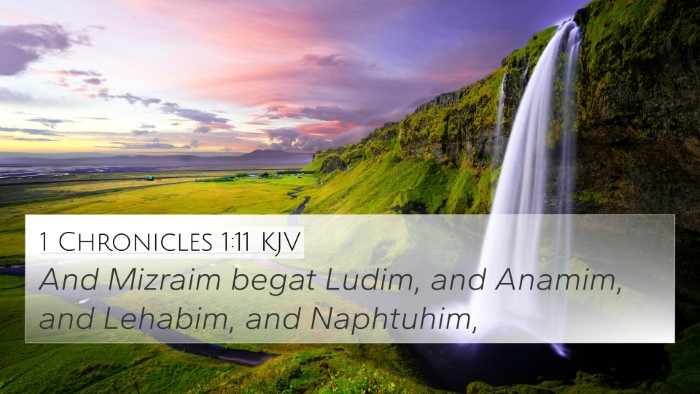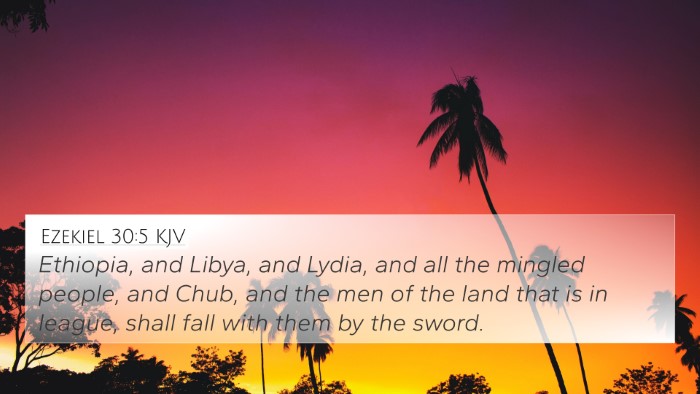Understanding Genesis 10:13
Genesis 10:13 states: "And Mizraim begat Ludim, and Anamim, and Lehabim, and Naphtuhim." This verse is part of the genealogical record in the Table of Nations, which outlines the descendants of Noah's sons following the Flood.
Summary of Genesis 10:13
This verse highlights the descendants of Mizraim, commonly identified with Egypt. The names mentioned refer to various peoples or tribes that arose from Mizraim, underscoring the extensive lineage stemming from Noah's family.
Commentary Insights
- Matthew Henry: Henry emphasizes the importance of genealogies in understanding the origins of nations. He points out that these names signify various tribes that became significant in the ancient Near East.
- Albert Barnes: Barnes explores the connections between Mizraim and Egypt, suggesting that this lineage indicates the ethnic groups that formed within the region. He notes that the names reference specific areas known historically.
- Adam Clarke: Clarke provides a linguistic analysis of the names, suggesting potential meanings or origins that connect them to historical tribes known from other ancient sources. He stresses the cultural importance of these mentions as representing real people and their legacies.
Bible Verse Cross-References
Genesis 10:13 finds relevance in several other passages, establishing connections between Bible verses:
- Exodus 1:1-5: Lists the names of Jacob's descendants, reinforcing the theme of lineage and nation formation.
- Deuteronomy 2:23: Mentions the various peoples descended from Mizraim, illustrating the geographic expansion of these tribes.
- Isaiah 19:1: Reflects on the significance of Egypt in biblical prophecy, tying back to its foundational lineage.
- Ezekiel 30:4: Discusses the role of Egypt in surrounding conflicts, echoing the consequences of the nations descending from Mizraim.
- Acts 2:10: References Egyptians among those present at Pentecost, thus linking them to the broader narrative of the spread of the Gospel.
- Luke 3:36: Details the genealogy of Jesus, connecting Him to fundamental biblical tales of ancestry that root back to Genesis.
- Revelation 11:8: Mentions Sodom and Egypt metaphorically, alluding to the moral and historical implications associated with these ancient lands.
Exploring Connections Between Bible Verses
Understanding Genesis 10:13 requires us to explore the thematic links and connections between Bible verses. These connections aid in interpreting how biblical texts speak to one another:
- Thematic Study: The genealogies serve to remind readers of God's providential care in human history, showing how He established nations leading to the coming of Christ.
- Cultural Analysis: The delineation of various tribes allows for a better understanding of ancient geopolitical dynamics and God's plan for salvation through specific lineages.
Comparative Bible Verse Analysis
A comparative analysis of Genesis 10:13 with other genealogical records in Scripture illuminates God's plan:
- Genesis 5: The line from Adam to Noah shows God's faithfulness through generations leading to divinely ordained events.
- Matthew 1: The genealogy of Christ connects these ancient lineages to the fulfillment of God's redemptive promise.
- 1 Chronicles 1: Provides further details on the descendants of Noah, reinforcing the historical accuracy of biblical narratives.
Tools for Bible Cross-Referencing
For further study on connections between biblical texts and themes, utilize the following tools:
- Bible Concordance: Helps locate verses and their cross-references throughout Scripture.
- Bible Cross-Reference Guide: Provides a systematic approach to studying connections between verses.
- Cross-Reference Bible Study: Focuses on identifying linked themes across the Old and New Testament.
- Bible Chain References: Enable users to connect verses in a meaningful sequence.
- Bible Reference Resources: Comprehensive materials that compile related verses and themes for deeper study.
Conclusion
Genesis 10:13, while it may seem merely a list of names, holds deep significance in understanding the unfolding narrative of Scripture. By cross-referencing and exploring connections between Bible verses, one gains a richer perspective on God's engagement with humanity through history.
Whether you're exploring biblical themes, preparing a sermon, or seeking to deepen your understanding of biblical texts, employing cross-referencing methods will enhance your study.
